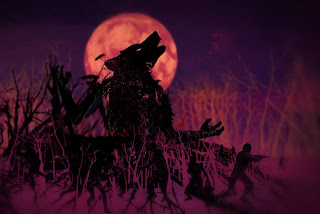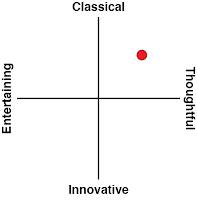Werewolf: The Apocalypse – Heart of the Forest treats players like they’re idiots. Other than that little issue, though, it’s a visually attesting, interesting, engaging and well-structured visual novel.
Just last week I published a video that talked about the Japanese concept of “ma” – an term used in the arts to describe the poignancy of “negative space”, or the idea that what is not there is as important and worthy of notice and reflection as what is there. As I mentioned in that video we don’t really have a similar concept for that in western art, and that changes how we tend to go about the arts. We use negative space, of course, but only when we’re deliberately trying to. It’s not something inherent to what we do.
We can apply ma to writing too (writing being an artform, naturally), and in writing a good way to think about it is simply that not everything needs to be spelled out in simple language. Furthermore, while it’s not quite the same thing, even the most pedestrian creative writing course will drum the idea that good creative writing is about “showing, not telling” to its students. It’s something that western visual novels often overlook, instead choosing to pummel you over the head with the literary equivalent of a sledgehammer.
There’s nothing subtle about the writing of Werewolf: The Apocalypse. The narrative absolutely has its heart in the right place, as a heavily pro LGBTIQA+, aggressively anti-capitalistic and anti-establishment bit of rhetoric. You also get to play as a werewolf (no, that’s not a spoiler – it’s right there in the game’s title), so there’s naturally a nod or two to the consequences of allowing yourself to slip into a rage and savagery that can help you at a pinch, but generally comes at the cost of having a more balanced perspective on an issue. You get the feeling as you play that this game’s story was created via a couple of sessions of the Werewolf: The Apocalypse pen-and-paper game, with a gaming group progressive enough to care about the messaging of the story.
It’s also nicely written, as far as the words used. There’s a rhythm and timbre to the writing which further substantiates in my mind that what you play here is a script to the pen-and-paper game, with words floating across the screen as though spoken by a particularly effective game master. I’ve played plenty of pen-and-paper RPGs in my time, and there is a performative quality that really lifts the stories when told by the better GMs. The narrative in Heart of the Forest isn’t voiced, but this game captures that same quality beautifully, making the delivery of each line compelling in its ability to drag you along for the ride.
It’s just as well the game’s only a couple of hours long, however, because the habit it has of spelling every key thematic takeaway out for the player would become exhausting were it to play out over any further length of time. It comes across as incredibly condescending, as thought the writers don’t think we’ll get the point unless they tell us what the point is. Say what you like about Kentucky Route Zero (and I know there are people out there that don’t click with it), but it, too, is a highly performative “visual novel.” The difference is that it never feels the need to spell out every moment that you’re meant to think and feel something.
Because Heart of the Forest is a visual novel, the quality of the narrative is of overwhelming importance, but assuming that you don’t mind the game talking down to you, every other element of it is pristine. It pretends that it’s an RPG by giving you a couple of different resources to manage: Rage, Will, and Health. As you play along different decisions will increase or decrease the number of “points” that you have in each category. In practice this is smokes-and-mirror stuff and a visualisation of the branching paths that the narrative can take you on, but it’s actually a clever representation of how the minimalistic approach to stats works in the tabletop game works.
Helping to set the mood is the art and music, and they absolutely nail it. The art has a beautifully savage, primal quality that vividly renders every scene in the brain. There’s some interpretation involved in it, since the characters tend to be indistinct and environments hazy, and is a deliberate effort to engage the imagination rather than just spoon feed players the impression of a character’s physical features and mannerisms that (ironic, given how lacking the narrative is in nuance). When the intensity really heats up, too (such as when you slip into werewolf mode), the accompanying discordant soundtrack and violent visualisation is particularly effective.
– Matt S.
Editor-in-Chief
Find me on Twitter: @mattsainsb









